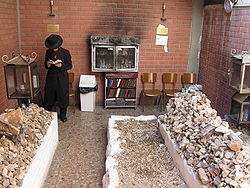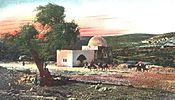- Ohel (grave)
-
 The graves of Grand Rabbi Avraham Mordechai Alter (right) and his son, Grand Rabbi Pinchas Menachem Alter (left) in an ohel adjacent to the Sfas Emes Yeshiva in downtown Jerusalem.
The graves of Grand Rabbi Avraham Mordechai Alter (right) and his son, Grand Rabbi Pinchas Menachem Alter (left) in an ohel adjacent to the Sfas Emes Yeshiva in downtown Jerusalem.
Ohel (Hebrew: אוהל; plural, ohalim, literally, "tent") is a structure built over a Jewish grave as a sign of prominence of the person buried within. Ohalim range from small wooden, brick, or plaster structures to large buildings which include one or more graves and area for visitors to sit and meditate.
Contents
Landmark ohalim
The graves of some (but not all) prominent Hasidic Rebbes and Jewish community leaders in Europe, North Africa, America and Israel are covered by an ohel. One or more graves may be included in the same structure. Landmark ohalim include:
Single-grave ohel
- Baba Sali, Netivot, Israel
- Chida, Har HaMenuchot, Jerusalem
- Yonatan ben Uziel, Amuka, Israel
- Elimelech of Lizhensk
- Chaim Ozer Grodzinski, leader of pre-war Eastern European Jewry
- Nachman of Breslov, Uman, Ukraine
- Nathan of Breslov, Breslov, Ukraine
- Rachel, wife of Rabbi Akiva, Tiberias, Israel
- Vilna Gaon, Vilnius, Lithuania
Multiple-grave ohel
- Avraham Mordechai Alter and Pinchas Menachem Alter, the third and sixth rebbes of Ger, Jerusalem
- Baal Shem Tov, the Degel Machaneh Ephraim, the Apter Rav, and Rabbi Boruch of Medzhybizh, Medzhybizh, Ukraine
- Avrohom Bornsztain and his son Rabbi Shmuel Bornsztain, Sochatchover Rebbes
- Dov Ber of Mezeritch and Zusha of Anipoli
- Shlomo Halberstam and Naftali Halberstam, the third and fourth Bobover Rebbes, New York
- Yosef Yitzchok Schneersohn and Rabbi Menachem Mendel Schneerson, the sixth and seventh Lubavitcher Rebbes, Queens, New York
- Joel Teitelbaum and Moses Teitelbaum the first and second Satmar Rebbes
Biblical figures and Talmudic sages
 Rachel's Tomb, covered by a distinctive, dome-shaped ohel, as it appeared circa 1910.
Rachel's Tomb, covered by a distinctive, dome-shaped ohel, as it appeared circa 1910.
Biblical figures and Talmudic sages are typically buried in ohalim:
- Benjamin (near Kfar Saba, Israel)
- Esther and Mordechai, Hamedan, Iran
- Habakkuk, northern Israel
- Judah, Yehud, Israel
- Rachel, near Bethlehem
See also
External links
Categories:- Jewish mausoleums
Wikimedia Foundation. 2010.
